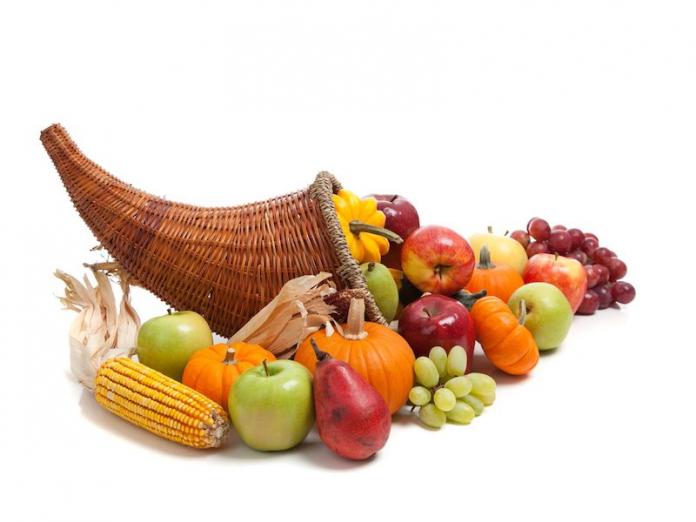What Does a Cornucopia Symbolize?
To understand the cornucopia, you have to start with Greek mythology and Zeus.

We often decorate for Thanksgiving with a cornucopia: a curved, horn-shaped basket filled with goodies like grapes, apples, and corn. It’s a symbol of fruitfulness and abundance.
But what’s with the word “cornucopia?” And where did its symbolism come from?
To answer those questions, we have to wade into the world of Greek mythology. I hope you’re ready, because this one’s a little strange.
To understand the cornucopia, you have to know Zeus
Let’s start with Zeus. Most of you know who he is: the most powerful of the Greek gods, lives on Mount Olympus, fights with lightning and thunder. Zeus was the son of two titans: Rhea and Kronos. They were the children of Uranus and Gaia. Uranus represented the earth; Gaia, the heavens. Yes, that means that Rhea and Kronos were brother and sister … and husband and wife. That’s just how they did things in Greek mythology.
It gets weirder.
Kronos was told by his parents that he would one day be overthrown by his own child. So, to be safe, when he and Rhea started to have children, he decided to eat them. Totally normal. One by one, he chowed down on Hestia, Demeter, Hera, Hades, and Poseidon.
Then, Rhea had Zeus. By this time, she was tired of all her children being eaten alive. So she swaddled up a stone and tricked Kronos into eating it instead of baby Zeus. Good thinking, Rhea!
Zeus was raised by … a goat?
Next, Reah took Zeus and hid him away in a cave, high in the White Mountains of Crete, and she left him in the care of a foster mother, Amalthea. Depending on which version of the myth you follow, Amalthea was either a goat who nursed Zeus, or a nymph who let Zeus feed from her pet goat. Either way, Zeus grew up fat and happy, full of goat’s milk, and warmed by the soft winds of the Mediterranean.
Here’s where we get back to the cornucopia. One day, Amalthea’s goat accidentally broke off one of her horns. Amalthea cleaned it up, filled it with flowers and fruit, and gave it to Zeus. In gratitude, Zeus placed the goat and the horn among the stars, creating the constellation Capricornus.
“Capricorn” comes from two Latin words: “caprum,” meaning “goat,” and “cornu,” meaning horn. Thus Capricornus – or Capricorn, as we say today – means goat-horned.
“Cornucopia” also uses the root “cornu” meaning “horn.” The second part of the word, “copiae,” means “plenty.” Thus “cornucopia” literally means “horn of plenty.”
We see these two roots in other words we know too. There’s “unicorn,” meaning “one horned.” And “copious,” meaning “plentiful and abundant.”
The goat’s horn symbolizes endless abundance
In another version of this myth, it was Zeus who broke the horn off the goat. He gave it to Amalthea and her sisters. And he endowed it with the power to instantly fill with whatever the holder wished for. Thus, this version even more strongly associates the cornucopia with the idea of endless abundance.
Finally, just for the record, there’s an alternate story about the origin of the constellation Capricorn. A different Greek myth tells of the deity Pan trying to escape from the horrible monster Typhon, a beast with a hundred snake heads and poisonous venom. Pan is usually depicted as a man with the hindquarters, legs, and horns of a goat. But apparently, he could also change shape. In trying to escape from Typhon, he leapt through some water. At one point, his front half turned full goat, while his back half turned into a fish tail.
Thus, the constellation Capricorn is often shown as a goat with the tail of a fish.
Greek mythology is full of stories like this, some that agree, some that contradict each another. You could say it’s a veritable cornucopia of tall tales.
Image courtesy of Shutterstock.
Sources
Dent, Susie. Amalthea. Brewer’s Dictionary of Phrase and Fable, 19th ed. Chambers Harrap, 2012.
Dixon-Kennedy, Mike. Amalthea, in Encyclopedia of Greco-Roman Mythology. ABC-CLIO, 1998.
Encyclopedia Britannica, online edition. Amalthea, cornucopia, Capricornus, Rhea, Zeus (subscription required, accessed November 14, 2019).
Oxford English Dictionary, online edition. Oxford University Press. cornucopia, Capricorn (subscription required, accessed November 14, 2019).
Persson Nilsson, Martin. The Minoan-Mycenaean Religion and Its Survival in Greek Religion, pp. 537–539. Biblo and Tannen, 1968.
Smith, William. Amalthea, in A New Classical Dictionary of Greek and Roman Biography Mythology, Harper & Brothers, 1878.




